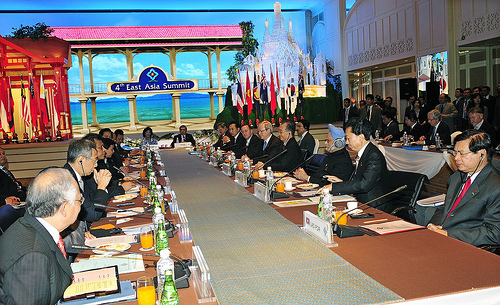This represents the quest for an elusive ‘Asian’ identity that could potentially blunt, if not transcend, nationalistic rivalries. Equally, it seeks to develop a mechanism for harmonising competing interests within a strategically balanced geopolitical and geo-economic architecture.
‘East Asia’ is not so much a geographical definition as a concept; a politico-strategic construct. Consequently, one primary criterion of inclusion in an ‘East Asian community’ should be shared economic interests and the willingness and ability of members to contribute to the region’s security, stability and prosperity.
Fortunately, we are not writing on a blank slate. Cooperative regional frameworks and institutions do exist in East Asia, albeit with overlapping activities that at times create confusion. Our frustration with their less-than-optimal functioning may be understandable, yet they continue to contribute significantly to confidence building and ingraining co-operative habits. These are essential first steps towards community building. We may not be able to emulate Europe, but East Asia is much better placed than, say, West Asia in terms of coherence, tolerance and stability.
Is a new regional body called for in order to fructify Prime Minister Hatoyama’s idea of an East Asian community? Instead of adding to the plethora of existing bodies, it may be more practical and effective to modify one of the existing frameworks. The task may be more clear and simple still if all stakeholders could agree on defining criteria for such a body. I would suggest the following guiding principles for consideration:
- A reasonably compact rather than a sprawling body;
- All members to be equal, without any concentric circles;
- An open and inclusive body that does not exclude any power with legitimate interests in the region;
- An ASEAN-centric body that would bring in countries that are summit-level Dialogue Partners of ASEAN, whether on an annual or periodic basis.
The last point requires some elaboration. ASEAN is the original regional organisation in Asia created to enhance the collective security and promote the economic development of its members and the region as a whole. If ASEAN were to be divided for the purposes of setting up an East Asian community, this may give rise to intra-ASEAN differences and power rivalries in the region. There is also the danger that such an approach would undermine the rationale of existing ASEAN-centric institutions. ASEAN as an organisation is not only the glue that holds its members together with a sense of common purpose and destiny. With sufficient, but not excessive, weight of its own, ASEAN has also served to bring together other larger powers around it.
Among the existing bodies, the East Asia Summit appears to be the optimal body for taking forward the idea of an East Asian community. Its suitability stems from many factors: It accepts a broader definition of ‘East Asia’; it is compact; it is ASEAN-centric; and it is avowedly ‘open, inclusive, transparent and outward looking’. Moreover, it is a relatively new organisation that is flexible enough to be moulded to suit today’s changing needs. Finally, it has the merit that it includes India.
However, the East Asia Summit (EAS), as presently constituted, does not include all those with a legitimate presence and a role in East Asia, notably the United States and Russia. While there is good case for the United States and Russia to be part of the EAS, one has to be conscious of possible pitfalls. Integration of the US economy with that of Asia is no small task and any individual bilateral security agreements would need to be re-examined. Caution concerning EAS membership expansion is understandable and consequently it may be worthwhile considering Observer or Associate categories, in addition to full membership.
What is the possible road map for an East Asian community? If ASEAN is to be at the core of East Asian community building, then the initiative lies with them. The short-term goal would be to try to evolve within the summit-level EAS more structured and regular Ministerial meetings to prepare for EAS summits. Currently, EAS Foreign Ministers and Economic Ministers have regular meetings, and EAS Ministers of Energy and Environment have met. With the now general agreement on ASEAN Defence Ministers Meeting Plus, this opens the door to EAS cooperation on security.
Given the complexity of the East Asian region, it would be unrealistic to expect rapid progress. Therefore, it is better to follow a step-by-step building block approach rather than have unrealistic ambitions for a top-down single grand architecture. Prime Minister Hatoyama’s proposal, and the public debate it initiated, is therefore welcome and timely.
Rajiv Sikri is a consultant at the Institute of South Asian Studies, National University of Singapore and a former Secretary at India’s Ministry of External Affairs. Last year he published ‘Challenge and Strategy: Re-thinking India’s Foreign Policy‘ (Sage, London and New Delhi, 2009).

